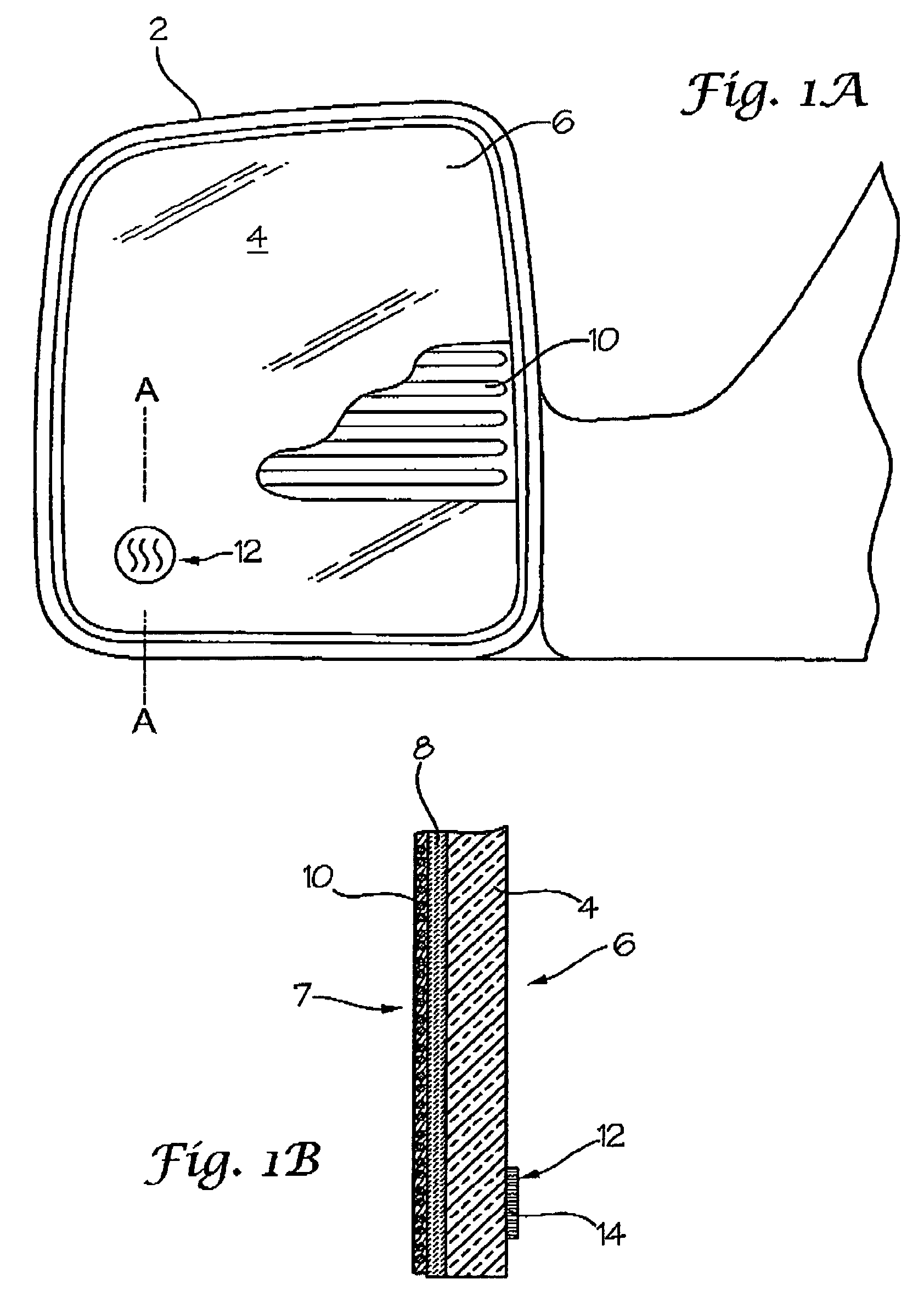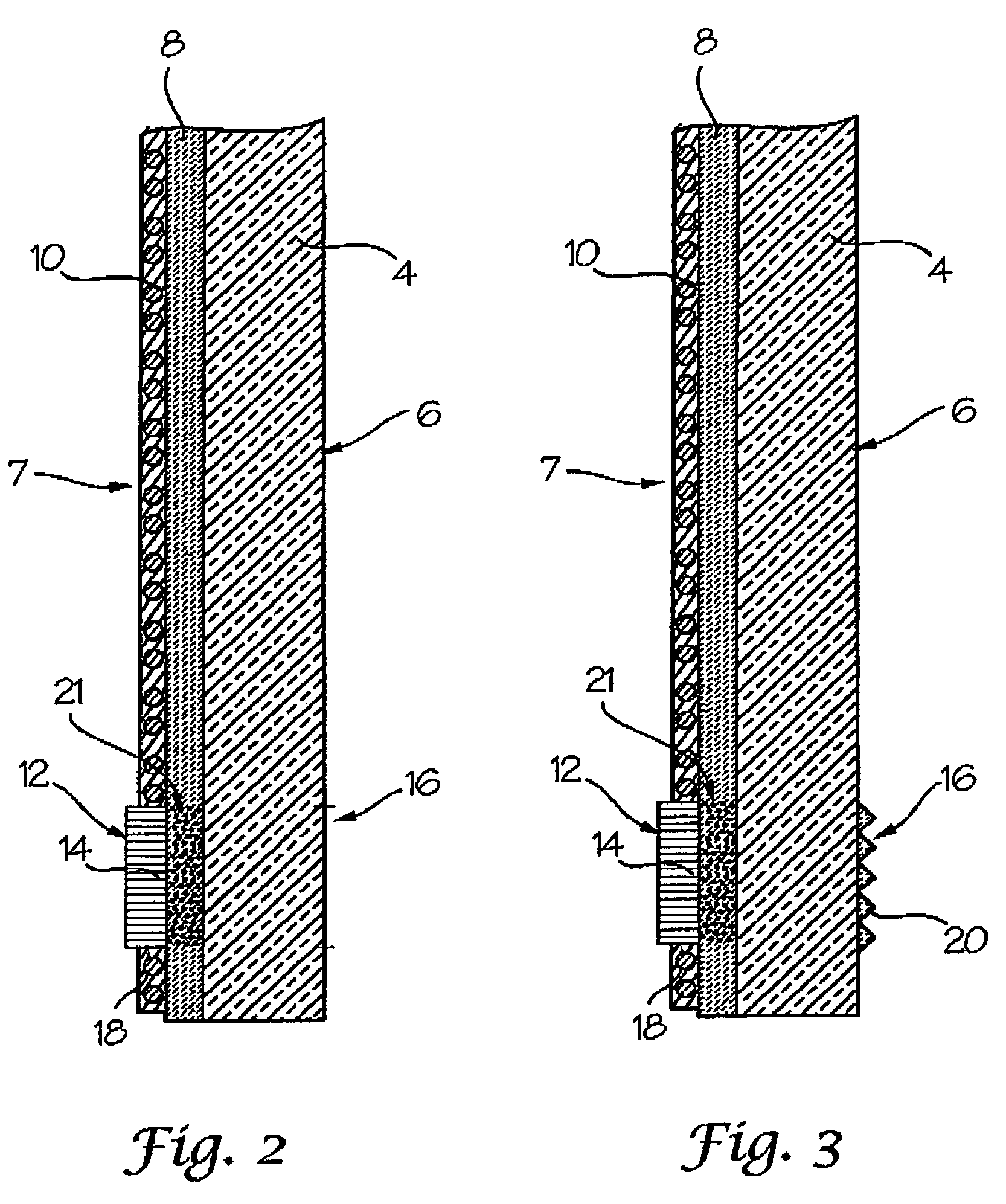Heatable external mirror for motor vehicles
a rearview mirror and motor vehicle technology, applied in the direction of electric heating, ohmic resistance heating, transportation and packaging, etc., can solve the problems of not being able to recognize whether the heating system of the mirror has already been installed, the mirror pane becomes “blind”, and the led must be built into the heating circuit. to achieve the effect of improving the visual indication and improving the visual indication
- Summary
- Abstract
- Description
- Claims
- Application Information
AI Technical Summary
Benefits of technology
Problems solved by technology
Method used
Image
Examples
second embodiment
[0026]FIG. 2 shows the invention in a drawing similar to FIG. 1b which is different from the embodiment of FIG. 1 in that thermochromic heating indicator 12, depicted as thermochromic foil 14, is not located on front side 6 of mirror pane 4, but in a recess 18 in heating element 10 on reflecting surface 8. The surface on front side 6 of the mirror pane 4 acts as an indicator surface 16. To ensure that the change in color is visible from front side 6 of mirror pane 4 at indicator surface 16, reflecting surface 8 is removed or at least thinned in the area in which the thermochromic foil 14 is installed to allow the driver to view thermochromic heating indicator 12.
third embodiment
[0027]FIG. 3 shows the invention differentiated from the embodiment of FIG. 2 in that in addition an optical enhancing surface structure 20, preferably in the form of small prisms, is provided on front side 6 of mirror pane 4 in the area of indicator surface 16. The prisms 20 improve the visibility of thermochromic heating indicator 12. Alternatively a Fresnel lens structure may be provided to enhance visibility. This optical enhancing structure is possible in particular in optical heating indicators in the form of elements made of a thermochromic plastic, i.e. the optical enhancing structure is integrated into the thermochromic heating indicator 12.
[0028]FIG. 4 shows a fourth embodiment with the same basic structure as the second embodiment according to FIG. 2, but thermochromic foil 14 reacts by changing in transmissivity and not by changing color in response to temperature changes. When thermochromic materials are used that react to temperature changes with a change in their tran...
fifth embodiment
[0029]FIG. 5 shows the invention which differentiates itself from the embodiment of FIG. 4 in that the thermochromic foil 14 with changing transmissivity is located on front side 6 of mirror pane 4. Reflecting layer 8 is thinned or removed, indicated generally by reference number 21, beneath colored marker strip 22 so that the colored marking 22 mounted in recess 18 of heating element 10 becomes visible from the outside of mirror pane 4 as thermochromic foil 14 turns transparent.
[0030]FIGS. 6a and 6b show a sixth embodiment of the invention, where a strip 24 of thermochromic foil is placed in heat conducting contact with the back surface heating element 10 and extends between mirror housing 2 and mirror pane 4 outward to the area of the mirror housing that is visible with front side 6 of mirror pane 4. Portion 26 of thermochromic strip 24 is visible from front side 6 and acts as an indicator surface 16 for displaying operation of heating element 10. In the area in which thermochromi...
PUM
 Login to View More
Login to View More Abstract
Description
Claims
Application Information
 Login to View More
Login to View More - R&D
- Intellectual Property
- Life Sciences
- Materials
- Tech Scout
- Unparalleled Data Quality
- Higher Quality Content
- 60% Fewer Hallucinations
Browse by: Latest US Patents, China's latest patents, Technical Efficacy Thesaurus, Application Domain, Technology Topic, Popular Technical Reports.
© 2025 PatSnap. All rights reserved.Legal|Privacy policy|Modern Slavery Act Transparency Statement|Sitemap|About US| Contact US: help@patsnap.com



